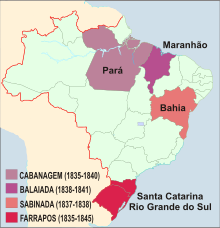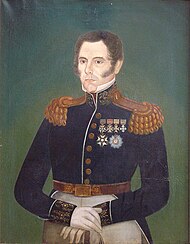War of the Farrapos

The Farrapos War or the Farroupilha Revolution are the names by which the republican and later separatist conflict that occurred between September 20, 1835 and the March 1, 1845 in the then province of Río Grande do Sul, reaching the region of Santa Catarina (Julian Republic) in southern Brazil. During this period, Río Grande became an independent republic (República Riograndense) whose presidents were Bento Gonçalves da Silva and Gomes Jardim.
The revolution, of a republican nature, influenced movements that took place in other Brazilian provinces, such as the revolution that would occur in São Paulo in 1842 and the revolt called Sabinada in Bahia in 1837, both of liberal ideology. It was inspired by the war of independence of Uruguay, maintaining connections with the new republic of the Río de la Plata, as well as independent Argentine provinces, such as Corrientes and Santa Fe. It expanded to Santa Catarina, with the proclamation of the Julian Republic in Laguna, and to the city Lages on the plain. Its leaders were General Bento Gonçalves, General Antônio de Sousa Neto, Colonel Onofre Pires, Colonel Lucas de Olivo, Deputy Vicente da Fontoura, Pedro Boticário, General Davi Canabarro, Colonel Corte Real, Colonel Teixeira Nunes, Colonel Domingos de Almeida, Major Vicente Ferrer de Almeida, Colonel Domingos Crescêncio de Carvalho, General José Mariano de Mattos, General Gomes Jardim, in addition to receiving inspiration from Italians from Carbonaria refugees in the region, and the help of the Republican Giuseppe Garibaldi.
At the time of the regency period in Brazil, the term "farrapo" (rag) was contemptuously attributed to the liberals by the conservatives (caramurus) and over time it acquired a laudatory meaning, being adopted with pride by the revolutionaries, in a similar way to what happened with the sans culottes at the time of the French Revolution. Many black slaves participated in this war seeking the opportunity for liberation.
Background and causes

The remote causes of the conflict are found in the secondary, economic and political role that the southern region, particularly the province of San Pedro de Río Grande del Sur, occupied during the regency. Part of the region was previously part of the Eastern Band of Uruguay, and was important in the defense of the territorial limits between Spain and Portugal.
Economic policy
Unlike the provinces of the southeast and northeast, whose production of primary products was destined for the external market, that of Río Grande del Sur produced for the internal market, having leather and jerky as its main products. The charque (salted meat), produced in the saladeros was used to feed African slaves, especially in the gold mines of the Province of Minas Gerais and the coffee and sugar farms in the region. from the southeast of Brazil. The southern region, in this way, was dependent on an internal market and suffered from external competition from neighboring Uruguay and the United Provinces of the Río de la Plata. The Brazilian imperial government, in order to get closer to Uruguay, did not demand import taxes.
As an immediate cause, Rio Grande do Sul was taxed more heavily than that produced in Argentina and Uruguay, thus losing competitiveness in the domestic market.
Foreign policy: independent Uruguay

It should be considered that Río Grande del Sur, as a border region, was militarized since the 18th century. Shortly before the uprising of 1835, the war had taken place with the United Provinces of the Río de la Plata for the possession of the Cisplatina Province (today Uruguay), where several Rio Grande do Sul soldiers and leaders had an important military performance, Bento Gonçalves da Silva and Bento Manuel Ribeiro among them.
Ideals from European republican movements
The Liberal Party in Brazil was closely linked to the Masonic lodges with ideals of equality, freedom and fraternity. The Italian secret society Carbonería and Giovane Italia of Giuseppe Mazzini, to which Giuseppe Garibaldi belonged, spread republican ideals in South America.
In fiction
This period of Rio Grande do Sul history is narrated in the novel The House of the Seven Women, by the Brazilian writer Leticia Wierchowski.
Contenido relacionado
International Committee of the Red Cross
Iruelos
University of Santiago de Compostela